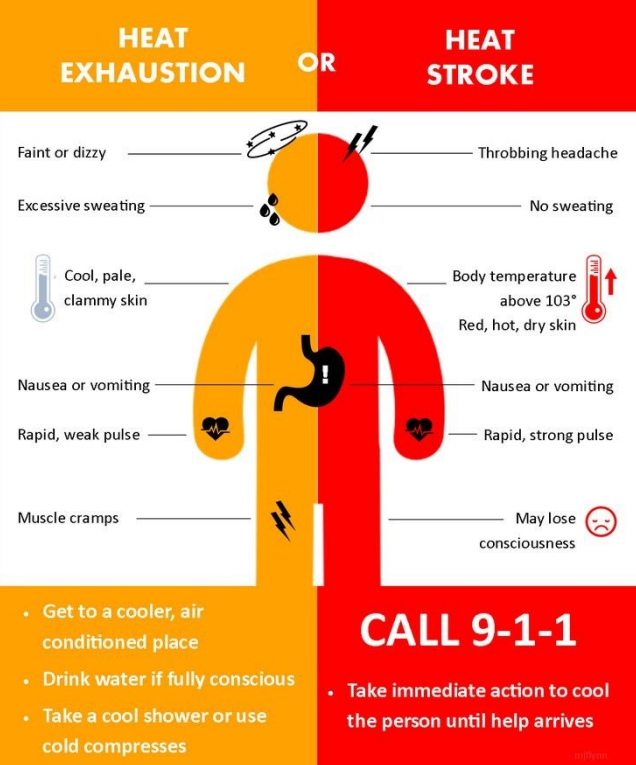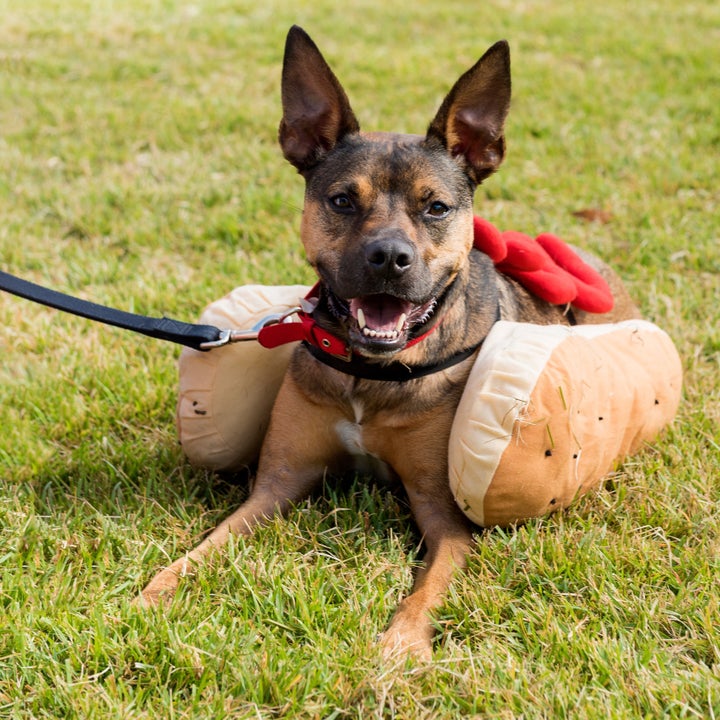[ad_1]
It’s getting hot out there, and it’s not just the mercury that’s rising.
The risk of heat-related illnesses has increased along with sizzling new temperature records that make it harder for the human body to naturally cool down to prevent injury or death, health officials warn.
Heat waves have become more frequent around the contiguous U.S. over the last several decades ― rising from an average of two a year in major cities to more than six ― and lasting longer than before. Extreme summer temperatures have also increased throughout the Southwest over the last 20 years, according to the National Oceanic and Atmospheric Administration.
If you’re not yet feeling the heat, climate projections over the next several decades suggest that you will. Here are some tips on how to stay safe and cool when temperatures are anything but that. Â
Where To Go And What To Do
Stay in air-conditioned buildings during the hottest hours of the day.
If your home does not have air conditioning or there is no power, which can happen during heavy electrical demand, the Centers for Disease Control and Prevention recommends spending time in indoor public places like shopping malls or public libraries.
Local health departments often set up heat-relief shelters, also called cooling centers, during excessive heat. Contact local government or health officials for help locating them.
If you are unable to find AC, officials recommend taking a cold shower, bath or sponge bath to lower your body temperature. Keep extra ice in the freezer to cool damp towels you can apply to your skin. If you’re using a garden hose to cool down, just be mindful of the water’s temperature ― which the Las Vegas Fire Department warns can reach 140 degrees in extreme heat ― before you spray it on a person or animal.
Forewarning: An electric fan is no equivalent to AC and will not prevent heat-related illness when temperatures are in the 90s or higher. Studies have found that a fan can make things worse if the air temperature is warmer than your body temperature or if there’s low humidity.
If you have to be outside, which should be limited to the morning and evening, stay in the shade and take plenty of water breaks.
For those who work in extreme heat, the National Institute for Occupational Safety and Health’s website offers extensive guidelines on how to reduce workplace heat stress, including advice on indoor facility designs, worker training, clothing, acclimatization, hydration methods and rest breaks.Â
What To Wear
Health officials generally recommended wearing lightweight, light-colored, loose-fitting clothing. If you’re outside, wear a brimmed hat and sunscreen, which should be reapplied as indicated on the package.Â
What To Eat And Drink
During hot weather, it’s especially important to drink plenty of water, including when you don’t feel thirsty or if your activity levels are low. The human body sweats to cool off, so your natural cooling system needs a frequent supply of H20 to keep it running smoothly.Â
“Everyone thinks that they drink enough water to stay hydrated, but in all actuality, most people don’t,â€Â David Ramirez, a public information officer with the Phoenix Fire Department, told HuffPost. In the summertime, when Phoenix’s average temperatures can top 110 degrees, the majority of medical calls are for heat-related illnesses, he said.
“If you’re feeling thirsty, you’re most likely already dehydrated, so drink water consistently throughout the day, throughout the night, especially if you’re planning on doing outdoor activities,†Ramirez said, adding that “we highly don’t recommend†such activities in extreme temperatures.
Generally, eating meals and snacks throughout the day, along with drinking adequate water, will maintain electrolytes and replace salt lost from sweat, the Red Cross advises. If you’re exercising or working outside in the heat, fruit juice or a sports beverage can also help recover salt and minerals lost from sweat.
Try to stay away from beverages with extra sugar, caffeine or alcohol, which lead to a loss of body fluid. Also try to avoid heavy foods, particularly ones high in salt, which can be dehydrating.
Practice Pool Safety
Drownings are a leading cause of “unintentional injury death†for children ages 1 to 14, according to the CDC. If a swimming pool is available to cool off in, remember to designate an adult to watch the children, said Ramirez.
“Here in the valley, we have a huge problem with drownings during the summertime,†said Ramirez. “Certain adults think that the other adults are watching the kids and before you know it … something fatal happens.â€
What To Do During A Heat-Related Illness
Heat is one of the leading weather-related killers in the U.S., resulting in hundreds of fatalities annually, according to the National Weather Service.Â
Get medical help immediately if someone is showing signs of heatstroke, which is the most serious heat-related illness. Signs can include a high body temperature, a strong or racing pulse, hot, dry skin or profuse sweating, a headache, nausea, dizziness, confusion and loss of consciousness.
If someone is showing signs of heat exhaustion, which can include a headache, nausea, dizziness, heavy sweating, or a rapid or weak pulse, help them cool down and get medical attention if their symptoms get worse or last longer than one hour, according to the CDC.Â

Ways to help someone cool down include moving them to a shady area or indoors, ideally into an air-conditioned room. Help provide a cool, not cold, bath or shower if available. Sponging with cool water also helps, as well as cooling them with a garden hose, but be sure to check the water’s temperature first.
If in doubt, Ramirez advised calling 911.
“You never know what may be happening with your body internally,†he said, adding that dehydration can make it hard to think clearly. “Just call 911 and whatever fire department is in your area is going to come and check you out.â€
Certain People Are More Vulnerable
Adults over the age of 65, children under 4, and people who take certain medications or have medical conditions such as heart disease are at higher risk of a heat-related illness, according to the CDC.
Children, in particular, are more vulnerable to heatstroke, with their body temperatures rising three to five times faster than an adult’s, according to the National Highway Traffic Safety Administration, which warns not to leave a child unattended in a car due to the lethal speed at which vehicles heat up to.Â
Try to make a habit of checking your entire vehicle, front and back, before locking the door and walking away to prevent an accident.Â
“Look before you lock,†said Ramirez. “Take a look in your backseat before you get out of the vehicle. Maybe put your purse and your belongings that you’re going to need in the backseat next to your child†so that you have to look there before you leave the vehicle.
Also, don’t forget to check on friends and neighbors who are at high risk of a heat-related illness.Â
“We have a lot of elderly people that live alone and unfortunately, sometimes their AC goes out and [they] don’t have landlines anymore. They have a cell phone but they don’t really know how to use it,â€Â said Ramirez.
Keep Your Pets Safe, Too

Make sure your pets have plenty of fresh water both inside and outside in a shady area. Outdoors, tree shade or shade from a tarp are ideal since they don’t obstruct airflow. A dog house can actually trap heat and be worse for a pet, according to the Humane Society of the United States. Â
Just like children, animals should never be left in a car unattended, even with the windows cracked open and for a few minutes. Temperatures inside a car can rise almost 20 degrees Fahrenheit within the first 10 minutes, even with a window cracked, according to the CDC. Some states legally allow car windows to be broken to rescue a trapped pet or a child.
Also, be mindful of the temperatures of hard-surfaced roads and sidewalks, which absorb the sun’s heat and can burn pets’ paws. Such injuries often occur when dog walkers visit a place that’s hotter than they’re used to or when temperatures are exceptionally hot, catching them off guard, said Ramirez.
“We’ve seen it time and time again where dogs will actually burn the pad on their paws and it will actually give them second- or third-degree burns,†he said.
Calling all HuffPost superfans!
Sign up for membership to become a founding member and help shape HuffPost’s next chapter
fbq('init', '1621685564716533'); // Edition specific fbq('track', "PageView");
(function () {
'use strict';
document.addEventListener('DOMContentLoaded', function () {
document.body.addEventListener('click', function(event) {
fbq('track', "Click");
});
});
})();
[ad_2]
Source link






